by Jordan Wolfson
(Painting Perceptions gives enormous thanks to Jordan Wolfson for this thoughtful and important essay and greatly appreciates his generous contribution. You can find more of his work and information on his website.) He is also leading a workshop “Painting as Interbeing” – May 5-8, 2014 in Colorado, you can contact him for more here.
 Jordan Wolfson, Still Life with Flowers (In Memory of Tamar B.) 2014, oil on linen, 18 x 16 inches
Jordan Wolfson, Still Life with Flowers (In Memory of Tamar B.) 2014, oil on linen, 18 x 16 inches
Click here for larger view.
Painting has no real context today. What I mean by that is that we have no larger story and meaningful myth within which to hold and nurture the activity of painting.
This activity that we call painting, that seems so clearly full of esteem as “Art”, has no place of stable purpose in our contemporary world. It’s rather arbitrary whether what a painter paints is going to be seen as important or not. It doesn’t correlate with whether the actual painting is any good—quality is not a mark against it, just not necessarily for it either. It has much more to do with how well the painter is able to interface with market forces; the galleries, curators, collectors, etc. That is, it has much more do with the context of the art world, and that has become a very odd context indeed. Further, given the growing secularization and fragmentation of our society we have no place of purpose and meaning for what we call art, and for what we call painting, as might be found in a more traditional culture where the sense of an overarching story is still intact. One can still hope to find a niche of the art world that might appreciate what one has to offer, but in terms of really contributing to a larger story the only thing we seem to be able to count on today, the only story with common consensus and shared terms, is the story of financial amount: how much is it worth? And that doesn’t really measure the value of the thing. The situation isn’t just possibly personally frustrating, it’s culturally bewildering and deeply saddening.
Other questions arise when one looks at the state of the world in general – where we seem to be headed. One doesn’t need to know the latest climate change information, the details of human trafficking, or worldwide poverty to wonder “What the hell am I doing? The world is burning and I’m sitting in the corner coloring? What does it matter, one more picture? What does it matter, one more painter?” It turns out it does. And more directly than we might think. What I would like to present here is a case for the utmost relevance of painting. The house is burning. If painting isn’t coloring in the corner, then what is it? How does it matter? Is there a way for painting to actually contribute to help heal our world?
The question of the meaning and purpose of painting has a history. The question of painting’s relevance only came into existence when the fine arts as a cultural category was gradually invented and then solidified in the eighteenth century. Until then, painting and painters had a clear role and place. As Larry Shiner delineates so well in The Invention of Art: A Cultural History, painting as an activity of image-making was always clearly imbedded in the cultural and economic needs of European society. The category of fine art, as a distinct realm of creativity in which paintings were made for their own sake out of the inspiration of creative genius, didn’t become a cultural norm until the eighteenth century. Before that, although there were steps being made in this direction from the time of the Renaissance, and although concerns of form and beauty were considered and essential, the term “art” as we know and use it didn’t exist. The vast majority of painters performed tasks that they were assigned through their guilds and through commissions; there was always a purpose and use to the images being made. The terms of individual creativity and the notion of art for art’s sake didn’t arise until art became separated from craft, the artist separated from artisan, and pleasure separated from utility and then ultimately refined into aesthetics. The rise of fine arts as a cultural category was inextricably linked to the rise of a market economy, a process of commodification, and a growing middle class. By the nineteenth century the normative view was that fine art was a separate realm of spiritual sustenance, ostensibly serving no other purpose than its own existence.
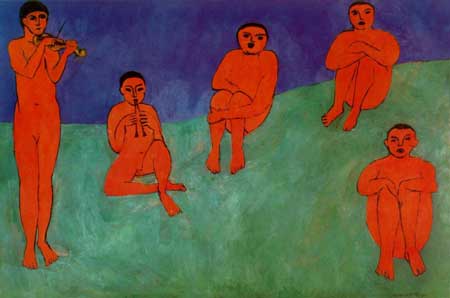 Matisse, La Musique, 1910, 102 x 153 inches, Hermitage, St. Petersberg
Matisse, La Musique, 1910, 102 x 153 inches, Hermitage, St. Petersberg
How we think about painting was and is extremely flexible. Our cultural attitude towards painting as an aesthetic object that must, first and foremost, exist for its own sake if it is to carry any real power, and that any use to which it is put threatens to harm its integrity, is an attitude with a history. It’s fluid, not inevitable. Perhaps the aesthetic power of a painting may be re-contextualized, revealing a larger purpose within a larger story.
Indeed, at the same time that this split in the eighteenth century was growing between craft and art, there was a pushback, a resistance to the stripping of art of purpose. There was an accompanying resistance to the split of art and life, this making of art into a distinct, separate realm with its own aesthetic jurisdiction. This pushback occurred from the beginning and continues down to our day. We see this resistance in the examples that Shiner brings: the works and writing of Hogarth, Rousseau, and Wollstonecraft. We can see it continuing in the work of Goya—giving testimony to the horrors of war and violence and injustice, with Manet and the other Impressionists, in their desire to eschew history painting and turn to the everyday life around them. We see it in the anti-art of Dada and Duchamp, in the 1960s with the developments of Fluxus and the Happenings of Allan Kaprow. We see it in the work and teaching of Joseph Beuys and the writings of Suzi Gablik, the work of Tim Rollins and the K.O.S., the community based works in Chicago curated by Mary Jane Jacob, the myriad of artists affiliated with the Green Museum, and the real estate development of Theaster Gates. Whether in the realm of social justice, community building, spirituality or environmental concerns, the claim of art as a pure domain of disinterested aesthetic contemplation has been relentlessly challenged for over two centuries.
Joseph Beuys, How to Explain Pictures to a Dead Hare (excerpt)
How is it that we have come to think of art as its own world with no purpose outside of itself? And if that makes no sense, than how does art function in our culture and civilization at this point? What are the various purposes for what we call art and which of them might we actually care about? The period of history in which painting had ostensibly no utility beyond the aesthetic is short, a gradual transitioning of two to three hundred years. Painting served various purposes before the onset of the realm of fine arts and it will continue to serve various purposes after the end of art as well. When I write of “the end of art” I mean the end of the story of art that we’ve been telling culturally, a narrative of sequential style that has viewed the long history of human making through the lens of the last two hundred years. Arthur Danto and Hans Belting have both written about this and come to similar conclusions independently: the story of art as we have known it is coming to a close. Larry Shiner, in his book, also speaks of this closure and asks what will be next.
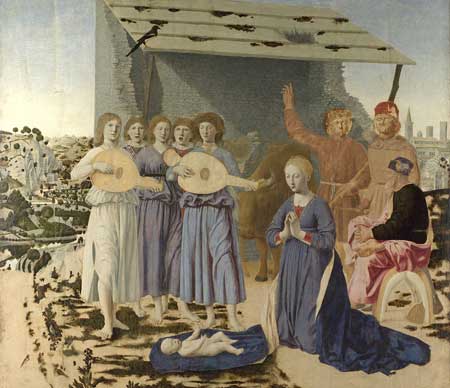 Piero della Francesca, The Nativity, 1470-75, 124.4×122.6cm, National Gallery, London
Piero della Francesca, The Nativity, 1470-75, 124.4×122.6cm, National Gallery, London
Before turning to try to answer that question let us first look at the possible uses that art has been put to, even during the period of history in which art was defined as necessarily having no utility, and up through today. Indeed, art does function as an opportunity for refined contemplative experience, and that is part of why we love it. It also functions as entertainment and distraction. It functions as decoration. It functions as philosophical inquiry. It functions as social action, as environmental action, as an inquiry into, and protest against racism, sexism and inequality and injustice of all sorts. It functions as financial investment, as a badge of social and class status, as a badge of cultural hipness and cool. It functions as religious icon and symbol and as a focus of contemplative meditation. Art functions politically, financially, socially, culturally, spiritually. Clearly, art functions. Clearly it has use and utility. We may not always agree to the uses to which an object is being put to use, but that it is done so is simply a fact of our world.
Given all of these various uses there is a function of art that is of particular importance: art carries presence. But then actually all objects, everything, carries presence. Nature, places, people—all carry presence. And there is the category of things made—some of those things we call art, most we don’t. Is there a difference in presence between art and non-art? Today, it seems that the quality of presence is not a determining factor of whether something is defined as art or not—the difference is simply the decision to name and claim that this given object is art. It can be anything. We have seen since the time of Duchamp that any object, even one that is factory made, can be turned into art by a switch of the mind.
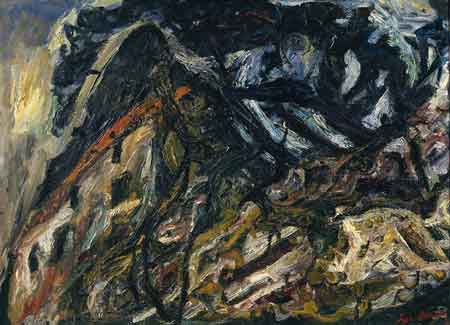 Soutine, Landscape at Ceret, 1920-21, 56x84cm, Tate, London
Soutine, Landscape at Ceret, 1920-21, 56x84cm, Tate, London
So, while strong presence is not the defining attribute of contemporary art, we do find throughout history objects that carry strong presence, and no matter the categories of those cultures, we have come to call these objects “Art”. That is, one of the functions of what we call art throughout time and place has been this imbuing of objects with presence. And whether the cultural category of fine art will continue or not, the practice of wielding and imbuing presence will carry on. It is an integral part of what people do. I believe this aspect of human making, to take raw material and somehow charge it with presence, is one of critical importance and I would like to now look at it more closely.
What is presence? And how does it get associated with an object? What is the process with which material gets charged or imbued with it? How is it that a human being can take colored mud, smear it around on a piece of fabric and end up charging the materials so greatly that it resonates with vitality hundreds of years after the person is long gone? How is it that a human being can take raw material and form it in such a way that it moves our hearts and quiets our minds? And what does this have to do with saving the world?
Titian, Saint Jerome in Penitence, 1575, Nuevos Museos, El Escorial, Spain
First, the question of the nature of presence: The experience of presence is consciousness becoming aware of itself. Eckhart Tolle writes about presence beautifully in his book The Power of Now: A Guide to Spiritual Enlightenment:
Have you ever gazed up into the infinity of space on a clear night, awestruck by the absolute stillness and inconceivable vastness of it? Have you listened, truly listened, to the sound of a mountain stream in the forest? Or to the song of a blackbird at dusk on a quiet summer evening? To become aware of such things, the mind needs to be still. You have to put down for a moment your personal baggage of problems, of past and future, as well as all your knowledge; otherwise, you will see but not see, hear but not hear. Your total presence is required.
Beyond the beauty of the external forms, there is more here: something that cannot be named, something ineffable, some deep, inner, holy essence. Whenever and wherever there is beauty, this inner essence shines through somehow. It only reveals itself to you when you are present. Could it be that this nameless essence and your presence are one and the same? Would it be there without your presence?
(Tolle, 1999, 96)
A little further on in the book Tolle defines presence:
When you become conscious of Being, what is really happening is that Being becomes conscious of itself. When Being becomes conscious of itself—that’s presence. Since Being, consciousness, and life are synonymous, we could say that presence means consciousness becoming conscious of itself, or life attaining self-consciousness. But don’t get attached to the words, and don’t make an effort to understand this. There is nothing that you need to understand before you can become present.
(Tolle, 1999, 98)
One of the gifts of making work, drawing and painting, is the possibility of becoming present—in fact, it’s a key ingredient to making strong, living work. And one of the gifts of viewing objects of beauty and strong presence is that they stop us still and invite us to become present with them, to meet their presence with our presence. This is a particular gift of all art forms, and perhaps the most important gift. This is how art awakens us, rekindles, reminds, re-hearts. We remember that we are alive, that things matter, that life matters. In this sense, beauty serves as a gateway to presence and sheer meaning. But what does presence as a function of art have to do with saving the world? And further, we seem to be talking about art in general, the power of presence that can be found in all making. Does painting in particular have something to offer that goes beyond the general category of art?
Diebenkorn, Ocean Park #79, 1975, 93 x 81 inches, Philadelphia Museum of Art
In an article on Richard Diebenkorn in the New Republic from the September 2013 issue Jed Perl wrote, “Ever since the Renaissance, painting has been the grandest intellectual adventure in the visual arts, a titanic effort to encompass the glorious instability and variability of experience within the stability of a sharply delimited two-dimensional space.” What Perl is describing here points towards something very specific and profound about the nature of painting. When he writes of the twin aspects of painting, the stability and instability that paintings exhibit, he is getting to the crux of the matter and may help lead us to the unique contribution and gateway that painting provides. Painting offers two contradictory experiences. On the one hand, a painting is a flat two-dimensional object, with its surface texture and color shapes. On the other hand, a painting offers the possibility of a three-dimensional experience, the illusion of moving into space and discovering form. Stability and instability. Fact and imagination. Actual and fictive. It is this twin role, and its simultaneity, that gives painting such power. Real and unreal. Real and more real. Painting, through the coexistence of two seemingly opposite experiences, interwoven into an actual unity, may provide the receptive adult the possibility of moving from an experience of fragmentation into an experience of wholeness and integration, not only within oneself but with the world at large. Boundaries between me and other, between inside and outside, prove to be not quite as firm as previously thought. This occurs not only because our minds are teased into non-discursive awareness by the shimmering interchange between the two-dimensional and three-dimensional experience; “I see a flat colored surface, no wait, I see a sky and valley below, no wait—will you look at those marks!” The experience of wholeness also occurs because the respective completeness of the two-dimensional and three-dimensional is each dependent on the other. That is, in order for a painting to maintain a consistent three-dimensional arena for the viewer to inhabit, in order for me to visually remain looking at and in the painting as a spatial situation, its two-dimensional composition must be complete—it must hold me visually, and then figuratively. Conversely, in order for the two-dimensional composition to be complete the marks and design, transitions and edges, must appropriately accommodate the parameters of the given three-dimensional experience, whether that is deep and far-reaching space like a Turner or more shallow as in a Braque, whether full bodied as in a Titian or subtly expansive as in a Matisse. Clement Greenberg got painting’s essence exactly wrong. It isn’t the stability of painting’s flatness—its “ineluctable flatness”; it is the inextricable unity of painting’s impossible flatness/fullness, stability/instability, stillness/movement. This is life. And this is why painting carries such an extraordinary metaphoric force.
Paul Cézanne, Mont Sainte-Victoire c. 1887 oil on canvas 26.4 × 36.2 inches Courtauld Institute of Art
Again, this may kindle an extraordinary aliveness and wholeness, but what does it have to do with saving the world? There is one more component that I would like to add to the mix and then I’ll try to put all the pieces together. Recently I came across a book, The More Beautiful World Our Hearts Know Is Possible by Charles Eisenstein. The basic premise is that the world we live in is truly unsustainable. It isn’t just a mess, it’s on the verge of truly collapsing. If we are not only going to survive, but also thrive, how are we going to get from here to there? Eisenstein attempts to find the roots of our situation, what has brought us to this point, and what must change, and it has to do with our story. That is, we tell ourselves a story about who we are, what is important, how the world works—important questions the answers of which lead us to create our world in a particular way. He describes our current story and offers an alternative one to help us transition into the more beautiful world we know is possible. Eisenstein writes:
We live today at a moment of transition between worlds. The institutions that have borne us through the centuries have lost their vitality; only with increasing self-delusion can we pretend they are sustainable. Our systems of money, politics, energy, medicine, education, and more are no longer delivering the benefits they once did (or seemed to). Their Utopian promise, so inspiring a century ago, recedes further every year. Millions of us know this; more and more, we hardly bother to pretend otherwise. Yet we seem helpless to change, helpless even to stop participating in industrial civilization’s rush over the cliff.

Francisco de Goya, The Colossus 1808–1812 Oil on canvas (46 × 41 in) Museo del Prado, Madrid
I have in my earlier work offered a reframing of this process, seeing human cultural evolution as a story of growth, followed by crisis, followed by breakdown, followed by a renaissance: the emergence of a new kind of civilization, an Age of Reunion to follow the Age of Separation. Perhaps profound change happens only through collapse. (Eisenstein, 2013, 3)
He goes on:
What do I mean by a “transition between worlds”? At bottom of our civilization lies a story, a mythology. I call it the Story of the World or the Story of the People—a matrix of narratives, agreements, and symbolic systems that comprises the answers our culture offers to life’s most basic questions: Who am I? Why do things happen? What is the purpose of life? What is human nature? What is sacred? Who are we as a people? Where did we come from and where are we going? (Eisenstein, 2013, 3)
Eisenstein describes for a few pages what he believes are our civilization’s answers to those questions and then precedes to offer an alternative of “interbeing”:
Here are some of the principles of the new story. That my being partakes of your being and that of all beings. This goes beyond interdependency—our very existence is relational. That, therefore, what we do to another, we do to ourselves. That each of us has a unique and necessary gift to give the world. That the purpose of life is to express our gifts. That every act is significant and has an effect on the cosmos. That we are fundamentally unseparate from each other, from all beings, and from the universe. That every person we encounter and every experience we have mirrors something in ourselves. That humanity is meant to join fully the tribe of all life on Earth, offering our uniquely human gifts toward the well-being and development of the whole. That purpose, consciousness, and intelligence are innate properties of matter and the universe. (Eisenstein, 2013, 16)
Frank Auerbach J.Y.M. Seated No. 1 1981, 711 x 610 mm Collection of the Tate
Eisenstein explains,
“The fundamental precept of the new story is that we are inseparate from the universe, and our being partakes in the being of everyone and everything else. Why should we believe this? Let’s start with the obvious: This interbeing is something we can feel” (Eisenstein, 2013, 16).
We painters know this, and experience this all of the time—it’s why we look at great painting! Painting directly participates in, enacts and furthers the story of interbeing. Painting is one way, surely among a myriad of ways, to further this story. But it is a particularly powerful way that I will try to describe. And for those of us that paint, painting is our way to lend ourselves to, and help facilitate, the Great Turning, because that is indeed what is happening.
In Eisenstein’s book, he moves through a series of short chapters, exploring various aspects of the situation we are facing. He has titled the chapters according to their focus, such as Separation, Breakdown, Cynicism, Force, Hope, Naiveté. Near the end of the book he has a chapter on Story and writes:
We have seen already how so much of what we consider to be real, true, and possible is a consequence of the story that embeds us. We have seen how the logic of Separation leads ineluctably to despair…We have seen how civilization has been trapped, indeed, in its “own postulates”, its ideology of intensifying control to remedy the failure of control. We have seen how so many of our efforts to change the world embody the habits of separation, leaving us helpless to avoid replicating the same in endless elaboration.
[T]o exit this trap we must operate from a larger context, a more comprehensive mode of consciousness. This means not only inhabiting a new story, but also working in the consciousness of story. If, after all, our civilization is built on a myth, to change our civilization we must change the myth. (Eisenstein, 2013, 213)
Morandi, Still Life, 1954, 26.5x41cm, Sainsbury Centre for Visual Arts, University of East Anglia, Britain
If indeed what is needed to shift our world is a new story, how specifically can painting contribute to a new myth and help tell this new story? Interbeing is a term coined by Thich Nhat Hanh, a translation of the words tiep hien. The word tiep means “being in touch with” and “continuing”. Hien means “realizing” and “making it here and now.” When we paint, whether from observation or memory or non-representationally, we have a situation which invites us to “be in touch with”, with what we see, with our inside – ourselves, with our outside – the world in which we live, with the places that slip back and forth between what is inside and what is outside—and to bring these places into our marking, our touch, and put into concrete form these sensations, in paint, “realizing” them, and further — providing others the opportunity to have these sensations slip into their selves. Painting seems to magically allow one subjectivity to slip into another, one person’s experience to be felt and embodied by another, from the inside! How can it be that one person may have a sense of another’s experience, somehow made available through dumb, raw material?
Earlier, I spoke of the twin nature of painting as both a two-dimensional reality and a three-dimensional experience. I would like to add to that and relate that twinning to interbeing. Our interbeing begins not with our relations with another person, but with ourselves, for we human beings are twin in our apparent nature. We are constantly and impossibly twinning and splitting in our experience. We are body and soul—or if you prefer, body and mind. And our identification with either leaves us incomplete because we are both (and, in our deepest truth, neither). Here the two-dimensional surface of the painting functions as the fact of our body and the three dimensional experience performs as our soul. The achievement of great painting, the exquisite integration of the two-dimensional and three-dimensional, gives us not just hope that wholeness is possible. More than that—great painting serves as a reminder, a rekindling, that such is the truth. Reality is whole. We are whole; it is only our minds that have slipped and reconstructed away from this awareness.
Monet, Water Lilies (The Clouds), 1903, 29.5 x 41.5 inches, private collection
The degree of availability that a painting presents, the availability of its trans-subjectivity, of our being able to enter into its space, its reality and being, depends on the degree of presence it embodies. The degree of presence a work embodies depends on how engaged we are when we paint, how much life force goes into the material, the sheer marking and making. This isn’t stylistic. It isn’t about closed marking or open marking, realist or abstract. It’s about life opening. It isn’t about emotional intensity, or velocity of marking. Marks can be slow or fast. It has to do with the amount of inner involvement, life-force, heat, the maker carries in the moment of the making. That is, the more we as painters bring ourselves into the work, the more open and vulnerable we allow ourselves, the stronger the presence and the more resonant the work, the more the work weaves the world.
Milton Resnick, Saturn, 1976, 97 x 117 inches, National Gallery of Canada, Ottawa, Ontario
Telling a new story isn’t a small thing. It is the thing. Painting does have a necessary and ancient function; it isn’t to depict the world—it is to weave the world; or rather, it is to reveal and make visible the actual weave of the world, the weave that already exists. What does this mean? When we paint we have the possibility of bringing our selves into the work—bringing our life force into the mark, the material, bringing our actual being, in this very moment, as it is, into our touch and setting free that vibration and energy. To do this is not easy, although it is simple. But it means daring to bring our actual selves, as we are, without judgment, into the work. It is also a risk and challenge to receive work, to open ourselves up to painting as a force from another person, another life, to feel safe enough to receive that force and allow it in. This also is not easy, although this too is simple. And we find that when we do open to the given surface that there may be a sense of aesthetic force, perhaps beauty, perhaps sheer presence, a kind of transmission from one person to another through the material. When we paint we are not simply making images, we are weaving our subjectivities, and we are doing this through the medium of colored mud on a flat surface—dumb material participating in the exchange and heightening of awareness. Painting is not simply an activity of self expression—it is an activity of interbeing, of our intersubjectivity, of our actual interconnectedness. Painting reveals this, gives proof to it in its very nature. We are not who we think we are. Painting carries the possibility of getting us out of our minds and into an awareness of our being. That is what occurs when we receive a painting, whether from another’s hands or from our own. The reality of our experience facing great painting, the power and force of transmission remains a mystery as long as we remain in the story of Separation. As we dare to allow our minds to enter into the story of Interbeing, painting affirms the larger truth of this new story. Its essential nature re-storys the world, reimagining who we are and where we are going. As we paint we have the possibility to not only make an object to look at, but to retell our story.
Berthe Morisot, In the Dining Room, 1875, 61.3x50cm, National Gallery of Art, Washington D.C.
Painting is currently trapped within the category of fine art. But what if painting isn’t about a picture, isn’t even about an object. What if painting, actually, is about the interaction between two minds, two hearts, two beings—the painter and the viewer? What if painting is about a way of coming to the world, a kind of communion? John Dewey writes in Art as Experience, “In common conception, the work of art is often identified with the building, book, painting, or statue in its existence apart from human experience. Since the actual work of art is what the product does with and in experience, the result is not favorable to understanding” (1934, 1). In other words, there is no work of art outside of our experience; that is where the reality of art is located. It is an interaction that reveals an inherent interconnectedness, an interbeing that reveals the illusion of separation. If that were our cultural story of painting what would that look like? What would an exhibition look like? Would that change the way we paint? What happens to the fetish of the object? The possibility of an interlacing communion through the lending of colored earth to human sensation: mud and oil embodying human consciousness. Rembrandt understood this.
Rembrandt, Self Portrait with Beret and Turned Up Collar, 1659, 33.3 x 26 inches, National Gallery of Art, Washington D.C.
Painting isn’t about beauty. Beauty is about consciousness. Beauty is a gateway, an adornment and invitation to space. The space within the painting. And space is consciousness. Space is being. When we paint we are exploring being. That is why we need the three dimensional illusion—it isn’t an illusion, it is a gateway—to being. We are experimenting with different ways of being. See Rembrandt. Cezanne. Monet. Morandi. Matisse. Titian. Piero. Chardin. Soutine. Martin. De Kooning. Diebenkorn. Auerbach. Kossoff. Giacometti. Resnick. This is what painting has to offer. It isn’t the object, for God’s sake. It is being.
I want to be clear that what I am suggesting is not, in my understanding, a new way of looking at painting. I believe that what I am trying to describe here is actually an ancient way of looking at painting. Images carry power. It is only with the rise and development of our secular culture with its accompanying market economy that painting has found itself delegated to a luxury commodity that is devoid of any real use and value in our society beyond sophisticated decoration, investment and chic. This is not particularly the plight of painting—so much in our culture has been radically reduced to a flattened materialist, financial definition—the logical endpoint in the Story of Separation. But the act of painting carries much greater power than that. And we need to re-describe this activity, re-imagine it, in order to sharpen its power and focus; in order for painting to more fully participate and take its place in our global regeneration.
De Kooning, Gotham News, 1955, 69 x 79 inches, Albright-Knox Art Gallery, Buffalo, NY
For many years now, thinking about the great painters of the 19th and 20th century, I’ve deeply envied them. It’s seemed to me that they, Monet, Cezanne, Matisse, Picasso, de Kooning—they lived at a time when a painter could still believe in painting. Painting really mattered. We certainly weren’t inundated with images like we are today, with television, movies, the exponential growth of the internet and the constant deluge of images from our mobile devices—how could images of paintings compete?
I doubt that painting will ever carry again the kind of privileged position that it once had up through the middle of the twentieth century. But painting does carry enormous importance as a hand-made object, revealing one person’s being to another, and in that revelation furthering the blossoming awareness of our irreducible interconnection and indeed, our interbeing. The earlier artists and painters of the 19th and 20th centuries had a great, eloquent and noble story called Art. I’m not sure we really have that narrative anymore—certainly not like we did in the past. But we might just have something greater—called the survival of our planet, the Awakening of Humanity and the Age of Reunion.
We do not, of course, have to believe this. We may choose to continue to think of painting as a wonderful activity of depiction. It is! And there is nothing wrong with that. But I am suggesting that there is a much larger story taking place and painting has a central, ancient place in the unfolding of that story.
Jean-Baptiste-Siméon Chardin, Water Glass and Jug c. 1760 Oil on canvas, 32,5 x 41 cm Museum of Art, Carnegie Institute, Pittsburgh
Painting Perceptions interview with Jordan Wolfson by Elana Haglar.
Sources:
Belting, Hans. 2003. Art History after Modernism. Chicago: University of Chicago Press
Danto, Arthur. 1997. After the End of Art. Princeton: Princeton University Press
Dewey, John. 1934. Art as Experience. New York: Penguin Group
Eisenstein, Charles. 2013. The More Beautiful World Our Hearts Know is Possible. Berkeley: North
Atlantic Books
Gablik, Suzi. 1991. The Reenchantment of Art. London: Thames and Hudson
Jacob, Mary Jane. 1998. Conversations at the Castle. Cambridge: The MIT Press
Perl, Jed. “The Rectangular Canvas is Dead.” The New Republic 7 Sept. 2013.
Shiner, Larry. 2001. The Invention of Art. Chicago: The University of Chicago Press
Thich Nhat Hanh, 1997. Interbeing. New Dehli: Full Circle Publishing
Tolle, Eckardt. 1999. The Power of Now. Vancouver: Namaste Publishing
Winnicott, D.W..1986. Home is Where We Start From. New York: Norton

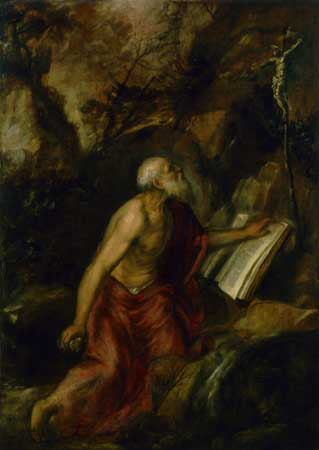
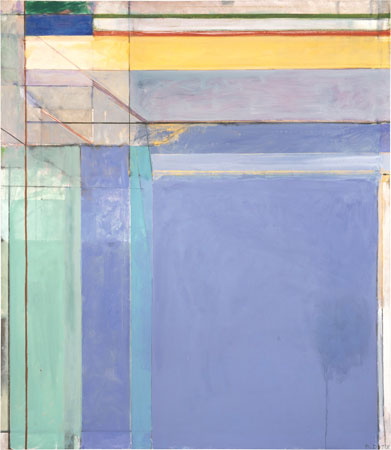
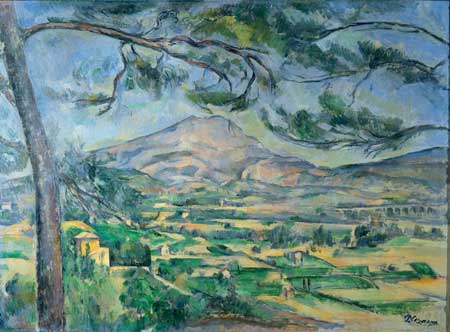
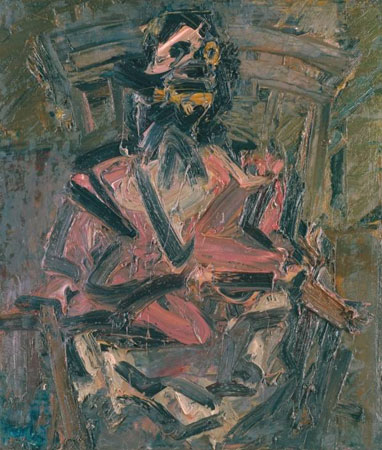
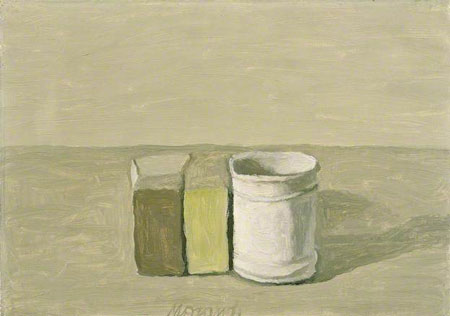
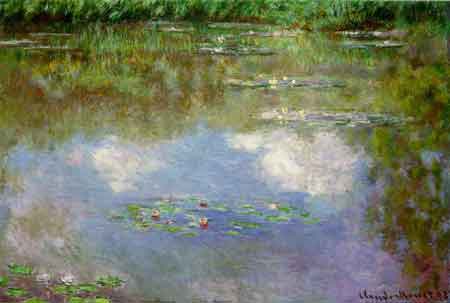
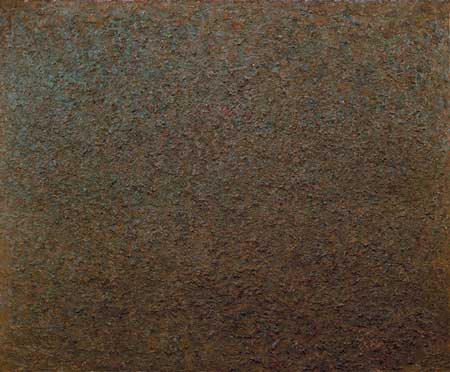
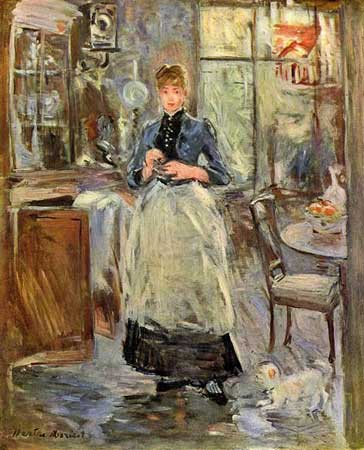
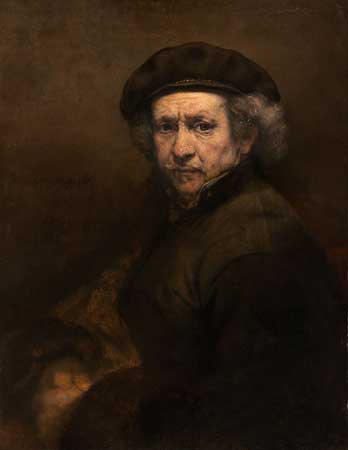
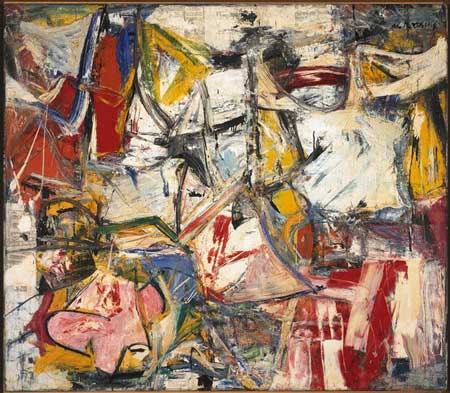
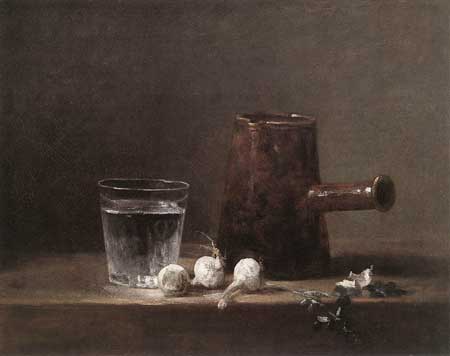




Wonderful! Recalls to mind Gaston Bachelard’s statements regarding “the astonishment of Being” in his excellent book, “The Poetics of Space”…
Thank you, Matt! I appreciate the response — and yes, Bachelard’s book is a beauty!
Jordan, you have managed to articulate much of what I intuit about painting. Sometimes I get brought down by the sense of uselessness of “coloring in the corner” but these convictions of the power and very human communication in painting keep me going. It is so encouraging to see my positive suspicions mirrored and expanded on so beautifully in your writing.
Thank you, Elana! Much appreciated — Always a pleasure to hear from you!
Beautifully stated Jordan. Your statement about making visible the weave of the world is simply perfect!
This is a pretty essay, well delivered and heart-warming. Thank you!
Thanks, Noel!
Wonderful essay…on so many levels. I’ve often, with painter friends and students, compared the act of genuine painting, the nature of being a painter, with being a Jedi Knight…being engaged in an ancient discipline of intimate contact with the essential energy that is core to the nature of being, the formative energy of all life. When a viewer is moved to shortness of breath after gazing for 15 minutes in front of a Vermeer…it’s not the “beauty expressed through the skill of a master painter” that takes the breath away…it is the embodiment of spirit; of that consciousness of awareness of being that the painter experiences during and through the “one-pointed” focus of concentration in the action of seeing and painting- of TRUE observing- that is expressed energetically (at a pure energy level) as a direct transmitting of ” PURE BEING-NESS” that does all the work. This communication on an energetic level is very well described in Stephen Harrod Buhner’s book THE SECRET TEACHINGS OF PLANTS. It’s about “communication” at the purest and most primal level of existence.
What should become obvious , as expressed, in this essay is the fundamental TAO – the dualistic-non-dualistic paradox within and about the holistic nature of life/ existence. In my classes and workshops, I re-define ART as follows….”a situational phenomena caused to exist or to take place, by an individual or group of individuals, as a way to describe or express a response to a situational phenomena”. The situational phenomena of a painting is a construct of relationships which involve a complex matrix of dualistic interactions and reactions of the visual elements …and their implications and impressions on the subconscious of the viewer. This matrix is COMPOSITION.
All Art is composition. All Life is Composition….a composition of communication of elements on both physical and energetic levels. All Composition is Communication.
As to the value of painting/ art to our culture. The essential overlooked aspect of painting/art in the Post Nineteenth Century dialectic of cultural esthetic arguments has been it’s character as LANGUAGE. A Language of PERCEPTION and BEING-NESS and AWARENESS. This language of Being-ness is more primal than any relevance of Art to a cultural time-place functionality or meaning. This language is one of the most immediate and accessible arenas for teaching and experiencing awareness about the nature of individual perception of self and how one’s “sense of perception” (as a set of skills) is culturally prejudiced….whether it has to do with a belief about what Art is,; what constitutes a good painting; what color green that grassy field is; just how dark is that shadow; etc. The process of looking at something to draw or paint it brings one in direct contact with how human perception functions …not just in the visual arena …but in all arenas of human experience…political, interpersonal relationships, self awareness, theology, science,philosophy, human behavior, religion, commerce, ….all value systems.
The paradigm of art/painting provides an example…living and approachable…from which to construct a set of skills for perceptual intelligence that are versatile for any situation one encounters in life. This intelligence of perception is an essential as the human race continues to forge selfishly ahead in it’s pursuit of the religions of “science,technology, and excessive capitalism and consumerism at the expense of the Earth itself.
The nature of the perceptual process employed in the visual language paradigm IS A DOORWAY into more profound…specific…even transcendent experience of being. It is a doorway, or as Loren Eisely might say…”a hole in the hedge” of reality through which one may enter into a new space of consciousness with which to engage in a dance with the MAGIC AND WONDER ON EXISTENCE/ LIFE. as JOSEPH CAMPBELL put it…”the artist is a shaman, who invites us to enter into the myth”…and that myth is the secret magic and power of the nature of existence.
What painting, the study and teaching of the visual arts methods- painting and drawing (especially in the foundation stages in working directly from life)have to offer is education in the greater language of the human experience…that along with other similar meditation practices can bring an individual into a meeting with the divine and eternal nature of his/her own uniqueness of being.
Thank you, Ron! You just put out a LOT of wonderful, inspiring ideas! Much appreciated! Onward!
Wow, I loved reading this, and I will certainly sift through it again and again. I loved your discussion of stability and instability and how those are expressed through the illusion of the surface; both two and three dimensional at once. I wonder what you think about the illusion of time in painting? We see an image unchanging as viewers, yet in the truth of it, it was created and expressed over time. Another way in which instability and stability are present in painting and describing inter being-ness?
Thank you, Mary! Yes, I think time is certainly a powerful ingredient in the mix – the paradox of simultaneous stillness and movement. Thank you for mentioning it! That’s a good question – the relationship between that paradox in painting and the aspect of interbeing — the way our lives are experienced in still, present moments and nevertheless through this relentless movement and change.
Hi Jordan,
Greetings from Downunder!
When I read your great article yesterday I felt thrilled and inspired. I had just been talking to my friend/colleague Geoff Duprée ( http://www.geoffdupree.com) that very morning about the vexed question of the role of painting in our contemporary era; he too, apart from being an outstanding artist, is an enthusiast for the work of Eckhardt Tolle. I am inspired by your idea about the crucial role of Presence in painting and drawing. I have been running a course called ‘Awakening The Eye’ for the past twenty years over here in Melbourne. It was generated, in part, by Frederick Franck’s book ‘The Zen of Seeing’- do you know it? I absolutely agree that we need to urgently redefine the place of painting and drawing away from its current role as investment commodity/social status symbol.
I think you have written an important and most relevant article and your choice of images- some of my very favourites!- eloquently communicates your message non-verbally. Thank you!
I hope to stay in communication with you and will continue to be inspired by this piece.
Anselm
Thank you, Anselm! Wonderful to know that the conversation is global! Yes, I remember Frederick Franck’s book – a lovely gateway – your course sounds great! I’ll check out Geoff Dupree’s work as well – thank you. So, yes, how do we actually begin to change the context on the ground? Can we interact with paintings differently? How do we change the story? I’ll keep mulling it over and keep you posted. If anyone has any ideas please post them!
Dear Jordan,
Thank you for your thoughts. I sense that you put your heart and soul into this. It resonates with many questions I have been asking myself about painting.
Ruth
Hello Ruth! Thank you – so nice to hear from you – and glad to know the article landed! And I’ve been meaning to tell you since I saw images from your last show — the work looks just beautiful — Really lovely! Looking forward to seeing it in person at some point —
BTW Jordan, I have been a huge fan of your work ever since I first saw it on Larry’s blog. I love the way you paint multiple works from the same subject…. You are an inspiration.
Thank you so much!
Hi Jordan – After taking a short road trip to deliver one of my paintings to a museum for an upcoming exhibition, I had what I considered an epiphany, if you will – a clear-minded, inner essay that I spent the bulk of my day today putting into words as succinctly as I could as to why I do what I do – what drives me to paint and draw.
In short, I basically expressed that through the time it takes to make a work, from conception to the last mark made, ideas are expressed, problems solved, and experiences are shared. Through all this the thing that drives me is the hope that a viewer may share some of that experience I had in making the piece – to realize that it is not just about the object that is hanging in front of them. It is the whole experience that went into making it. I was just blown away with the after life of some works as well: the experiences and associations that continue long after a work is completed.
Happy with what I managed to put into words and before going to bed, I open Painting Perceptions and happened upon your inspiring writing. Thank you so much. I will pass this on to anyone who will look and listen. And I will continue to study it in-depth for a long time. You have a rich, masterful way of communicating. Bravo!
Thank you, Kris! It sounds like we were trying to express something in a similar vein! Yes, somehow the object, the painting, is just the front-end of something very large going on – that weave, perhaps. I’m just now starting the most recent book by Lewis Hyde – he wrote The Gift, a superb and important read – and this book now, Common as Air – Revolution, Art and Ownership, somehow seems relevant to this whole conversation. Looking forward to it!
Will read and love your work –
Wow! I’m stunned into a lack of words except for Wow. Thank you and thanks for the list of great books to read too. There really is a deep sense of interbeing out and about these days, many people disillusioned by the current state of affairs going to share it all over the place as I know SO many people of all stripes who need to read this.
Thank you, Ann! Much appreciated. Yes, I’m hesitant to speak with certainty but something does seem to be moving “out and about” as you put it. Is it real? Eisenstein deals with that question – pretty well, I think. Yes, please do pass it on!
Besides sharing a name, our ideas about painting are very closely aligned, except I think I might be a wee bit more cynical or something. I invite you to have a look through through http://www.jordanquintero.com. I’d also like to recommend Levy’s The Technicians of Ecstasy and a book I just found by Henry Miller about Rimbaud called the Time of the Assassins, written post-war, an amazing piece of writing that has some extremely pertinent observations about consciousness, the apocalypse, and art that I think you and your readers might enjoy. I’ve been working with and thinking about the relationships between mythologistical processes and visuality and why paint? (not video or installation or self-mutilation or whatever) for a long time, it’s nice to see some of these ideas in discourse. What do think that painting’s concrete political value, as an act and/or vocation, not only from a metaphysical but from a pragmatic point of view, is? Do you ever feel it could be an act of self-sacrifice, not necessarily overt, but more of an existential act of protest, a non-engagement strategy with the military indstrial complex, a pacifistic way to spend one’s life, and that that type of action carries an essentially political scope? I feel that my painting is often that, my choice to paint, part psycho-pathology, part syncretic religious practice. Maybe those are the same thing. Anyway, Bravo on the essay, love the artwork, also, so painty! What famous artists did you go to Yale with? Cheers
JQ
Thank you, Jordan — glad to read your thoughts and associations! Thinking about your question at the end, about how one might frame one’s painting practice as a strategy of non-engagement with the military-industrial complex – you might be interested in a book by John Berger, “The Shape of a Pocket”. In the first essay of the book Berger describes the possibility of painting as, in and of itself, an act of resistance. Very much in line with what you’re pointing towards —
Cheers to you too!
Dear Jordan,
Exactly. Well-said and justifies the urgency of why we continue to paint today. I am going to quote you in my upcoming artist talk.
Warm regards.
Thank you, Val. I hope the talk went well!
Wonderful essay.
A resource that builds on the need for a new story, and as well on interbeing, is the work of the astrophysicist Brian Swimme. He did a series of talks on DVD, available on Amazon, called “Powers of the Universe” which confirm and expand on Jordan Wolfson, Eisenstein, and Thich Nhat Hanh. Simply naming Swimme’s powers may suggest their relevance to painting: Seamlessness, Homeostasis, Emergence, Allurement, Centration, Cataclysm, Synergy, Transmutation, Transformation, Interrelatedness, and Radiance.
Fabulous! Sounds wonderful, Winslow – I’ll check it out. Much appreciated!
The house is on fire.Does painting really have any impact OR relevance?People kill Monkeys and great Apes for food when they have plenty to eat.The world is to insane to see or hear.Man is the only animal to be dreaded.
Painting must be a religious act and not a commercial one full of self interest,just another technical skill applied for profit on any level of self .Personally I hate the misuse of painting.
This thread, the place of art in modern society, has been seeping into my awareness recently. I have long secretly felt that doing art was really self-indulgent in comparison to activities that cater directly to basic human survival needs. It hasn’t redirected my activities, however- so the seeds of guilt are still there. I just finished reading, “Art As Therapy” by Alain de Botton, in which “A Hypothetical Commissioning Strategy” is proposed. This book doesn’t address art as a therapeutic method for the artist, but rather as a potential means of helping society to learn and to cope with various specific issues of living. I mention it only because of notion of the purposefulness of art, as opposed to decoration or financial investment. It does not touch upon this idea of “presence” which speaks more to the inner process of perception and communication, I think. Very interesting and thought provoking. Thanks so much.
I have to breathe as I have to paint or There will be death whatever the world around does??
“The existence of a civilization presupposes a public that has both the time, and the need, to draw sustenance from the high-wire acts of the artistic imagination. The United States never has produced such a public in commercial quantity, a fact remarked upon by the art historian Robert Hughes in the shock of the new, who also wrote: ‘Art discovers its true social use, not on the ideological plane, but by opening the passage from feeling to meaning—not for everyone, since that would be impossible, but for those who want to try. This impulse seems to be immortal.’
Happily so. What blocks the passage from feeling to meaning is the replacing of the thing itself with the price or theory of the thing, which is the difference between money and art as the universal medium of human exchange proposed by Arthur Schopenhauer: ‘Money is human happiness in abstracto, consequently he who is no longer capable of happiness in concreto sets his whole heart on money.’ The dictum accords with the twentieth century’s wars and devourings of the earth, accounts for the modernistic expressions of alienation and despair, speaks to the price paid for the shark in formaldehyde.
Although it’s frequently said that the truth shall make men free, the precept is almost as frequently misunderstood. Truth as synonym for liberty isn’t a collectible. It is the joyous discovery of the enlarged sense and state of being that is the change of heart induced by the presence of a work of art.” —Lewis Lapham
Thank you for this Jordan, you’ve articulated so much of what I’ve felt about what painting but lack the where with all to put into words. I’m very happy to have found this…
For Jordan – this is a very heady, well-framed, convincing, meaningful construct of everything that I have come to believe about what painting is and why I paint and what I am reaching for (or attempting to release myself from).
However…. my current frustration is: what the hell am I to do with all these paintings? “Why paint” is one question that I will continually ask myself for the rest of my days and not necessarily need one definitive answer. The more practical issue of what to do with them is a whole other matter. I am a serious artist, but not a professional one. It’s important. Or maybe it’s not. Unless one’s work is in high high demand, there are honest paintings doomed to be sold at yard sales or donated to the art league for re-purposing. My children are destined to be left with a house full of earnest paintings with which they’ll have no idea what to do.
(Help? Anyone?)
Rapturous. Eloquent. Pertinent. By appealing to the core sensibilities of the reader, this elegant essay accomplishes exactly what the author describes as the cultural contribution of fine painting. The text commemorates the role of painting in the past, and offers a compelling plea to today’s painters to perpetuate this celebrated history by acknowledging the abiding power of pigment and brush. When they are held in the hand of an artist who transcends depiction and self-expression, they breach the gap between creator and created, as between transmitter and receiver, and meld us to enchantment.
Linda, my goodness – such beautiful language and sentiment! May it be so! God knows, these time need faith, and commitment, and enchantment —
I am grateful for this illumination Mr. Wolfson and the introduction to the books by Shiner and Bachelard I just ordered. I’ve enjoyed/read The Tolle book sited. Your central tenet of Presence holds the flame for me. I thought of Giacometti throughout your call to arms to animate and resuscitate painting’s portal to Interbeing. In his conversations with James Lord or David Sylvester Giacometti circumnavigated the pursuit of Presence in elliptical speech, with a portraitist’s laser gaze and, of course, by whittling plaster from inanimate something to the brink of collapsing nothingness. Somewhere in there he would spot the ghost in ocular nearness + farness conundrums of Presence. As for the “end of the story of art” it seems wherever you have an ideology calcifying you also have the portent of it’s demise built in and Art as commerce is inseparable from the ideology of Capitalism which is teetering on implosion. So much Art is not commerce however and the diverse tendrils of the act of art making will continue throughout a collapsing civilization. The story changes with the evolution. I think of painting particularly as being as an indispensably human activity as sex which you could also divide into subcategories of utility or for it’s own aesthetic sake, commercial/noncommercial.
Recently the collective consciousness of American artists in particular has pondered the question of your article. There’s a lot to parse out and a lot to confuse in trying. I for one was happy to read the date of this piece before advancing especially in light of more topical articles like
“Art Must Admit the Lesson of Donald Trump’s Election or Face Irrelevance. We need to reckon with the shock if we are to combat the horror effectively.”
by Ben Davis
To quote the Bollywood movie, “It will all be alright in the end and if it’S not alright then itt’s not the end.”
Thanks for your insight and Presence filled art.
Sw
Thank you for this lovely careful piece of writing. It contained a lot that I’ve been telling myself for ages but told here with such clarity and gracefulness, especially about the magical relationship between a painting’s space and its surface. And the ability for individual conciousnesses to share a spiritual/mental space in a way that poor words can never do. If I were to take issue with anything it would be the repetition of “great painting”. I know what you mean but the emphasis on greatness automatically creates a kind of market hierarchy. “Exemplary painting” maybe? I know that in all of the arts really good stuff is rare, but that doesn’t mean that the best need drive out the good. Many thanks again.